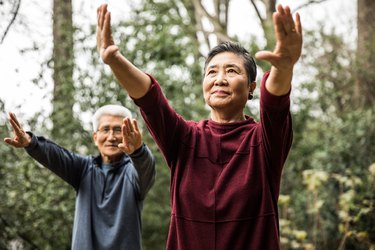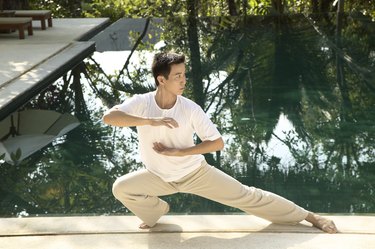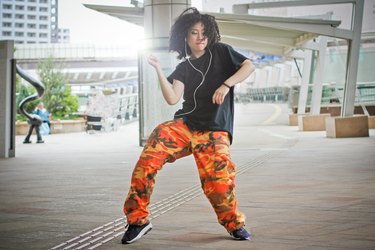
Tai chi is an ancient martial art that originated in China, but it has a host of benefits for aging healthfully in our modern world. One major research-backed benefit: injury prevention.
"There are a lot of compelling benefits of tai chi, in the context of preventing or even rehabilitating injuries," says Peter Wayne, PhD, associate professor of medicine at Harvard Medical School and director of the Osher Center for Integrative Medicine.
Video of the Day
Employing a series of gentle movements, physical postures, a meditative state of mind and controlled breathing, tai chi may be beneficial in improving balance, preventing falls, improving quality of life and more, per the National Center for Complementary and Integrative Health.
Here's what you need to know about how this practice can prevent injury, plus six movements to help you get started.
7 Ways Tai Chi Can Help Prevent Injury
1. It Can Improve Your Joint Health
Tai chi benefits your joints by improving muscle strength and coordination, leading to improved joint stability, per Harvard Medical School.
"When you're over 50, you start losing some muscle mass, leg strength, and balance," says Shirley Chock, CCWS, owner of Aiping Tai Chi in Milford, Connecticut, who provides tai chi training videos on YouTube. "This is one area where tai chi can really help to prevent injury. It can gently increase the strength of ligaments around your joints and improve the ability and range of motion around joints."
In fact, participants with knee osteoarthritis who practiced tai chi twice weekly for three months had less pain and better physical function than those enrolled in a wellness education and stretching program, per a small, classic January 2011 study in Arthritis & Rheumatism.
2. It Makes You More Mindful
Paying attention to your body is a key element of avoiding injury, which tai chi can help with.
"Tai chi is a whole-person exercise, so it's not just moving your physical body, but also engaging various aspects of your mind and mindfulness," Dr. Wayne says. "Acute awareness of the state of our body, like how much we push ourselves for the day or what will happen if we extend a joint a certain way, can prevent injuries."
When you practice tai chi, you may find you have a better sense of what your body is feeling.
"There's a concept called interoception, which is the awareness of your inner physiology," Dr. Wayne says. "People who practice these mind-body exercises tend to have a better read of what's going on and a higher sensitivity to sensations in their body."
Mindfulness can reduce your risk of injury at any age. For instance, soccer players who participated in seven weekly group sessions focusing on mindfulness exercises and acceptance techniques had fewer injuries than a control group in a March 2020 study in the Journal of Sport and Exercise Psychology. (It's important to note this study was done specifically with young male soccer players.)
3. It Improves Your Body’s Alignment
Tai chi promotes the structural alignment of your body, so you move in one interconnected movement.
"When you move in a disconnected way, it requires a lot more strength for those individual muscle groups to do that function," Chock says. "As we get older and we don't have the same strength in our muscles as we did when we were younger, it becomes even more important to connect the body's internal structure to utilize the whole body in movement."
Tai chi helps you understand this connection and move your body as one connected entity — rather than moving the different muscle groups in your arms, legs and other body parts separately.
4. It Helps You Practice Moderation
When you practice tai chi, you learn to practice and live with moderation, which can also help you prevent injury.
"In tai chi, we never push it — there's always a little bit of reserve, like stretching to just 70 percent of your full potential," Dr. Wayne says. "If you recall the yin-yang symbol, there's always a little bit of light on the dark side and vice versa."
As you grow older, you may find that your range of mobility diminishes. If you're not aware of the limits of your range and you try to move beyond it, that can lead to injury.
"In tai chi, we're not trying to do very large movements," Chock says. "It's important for you to be aware of your own center and balance — and not go outside your range of mobility."
This can include moderating the length of strides you take when you walk or not overextending your arm when you reach for a coffee mug from your cabinet.
5. It Reduces Your Risk of Falls
Older adults who practiced tai chi had a significantly lower risk of falls compared with a control group, according to a September 2016 review in the International Journal of Gerontology.
In tai chi, you reevaluate the mechanics of walking and learn how to stride in a way that reduces fall risk. Normally, when you walk, you push off your back leg to launch your body forward — and then your front foot connects to the ground. However, this resembles the motion of a fall. There's a moment in which you're not connected to the ground, so if something is in the way of your front foot connecting to the ground, it can lead to a tumble.
"In tai chi, we walk differently," Chock says. "We actually don't push ourselves off the back foot to come forward. We stay connected with the back foot, and when we bring the front foot forward, we wait until we feel balanced until we shift all the way forward. It's a much more balanced and rooted way of walking."
Tai chi can also help with balance by promoting your spatial awareness.
"Another inner sensation is what's called kinesthetic sense or proprioception," Dr. Wayne says. "Tai chi improves this sense of your body's position in space."
6. It Improves Your Overall Mobility
Tai chi and qigong (a similar practice rooted in traditional Chinese medicine) have been shown to have physical and psychological benefits for stroke patients, who often experience impaired mobility and physical function. Practicing tai chi and qigong for 12 weeks or less was effective in improving the mobility of stroke survivors, per a November 2022 review in PLOS One.
"Tai chi is really focused on opening up the area around your joints and improving the range of mobility around them, particularly in the groin, hip and spine areas," Chock says. "These are areas that become very tight, especially when you don't exercise much."
Modern lifestyles often lead to long periods of sitting, so those parts of your body may not get much movement. Tai chi aims to give you mobility around these joints.
"We want to be able to move the way a ball moves," Chock says. "If it bounces against a wall, it can keep rolling because it has a full range of motion all around. Those are the exercises we do in tai chi as we move."
7. It Can Change Your Mindset
By practicing tai chi, you also practice acceptance.
"Tai chi is a philosophy rooted in the concept that we have to accept there is constant change in the world," Chock says. "When we embrace this concept in our mindset as we age, it allows us to accept and embrace that our body will change."
What you can do when you're over 50 will be different than what you can do in your twenties — and that's perfectly OK.
"Being accepting of that change can also help to prevent injury," Chock says. "So often, people try to do what they remember they could do when they were younger — and are not connected to what their body is capable of doing in the current moment."
It's just one mental health benefit this practice can have: Tai chi significantly improved most outcomes for older adults in a November 2022 review in the Archives of Gerontology and Geriatrics. This included improvements in psychological distress, depressive symptoms, anxiety, cognitive function, mental speed and attention, learning ability, verbal fluency, executive function and quality of life.
6 Tai Chi Moves You Can Do for Injury Prevention
1. Parting Wild Horse’s Mane (Legs)
This movement teaches you to walk in a more centered and controlled manner by keeping your weight in the back support leg as you take a step.
"By maintaining your center and balance when you step, you can prevent falls from happening because you are rooted in your step," Chock says.
- Step forward without shifting your weight forward.
- Shift your weight to the middle, so weight is even in both legs.
- Turn to face forward and shift your weight forward. Keep your knee in line above your toes. Your back heel should stay on the floor.
- Shift your weight backward. Keep your front leg “empty” in terms of weight.
- Turn toward the corner from your hips.
- Shift your weight forward and bring your back left foot forward. (Visualize how a cat walks.)
Tip
- Keep your pelvis and lower back relaxed to maintain proper alignment for balance.
- When your weight is forward, don't let your front knee go past your toes to prevent knee injury and pain.
- When shifting your weight backward, don't let your back knee collapse in; keep it open and aligned with your toes in your back foot to prevent knee pain and injury.
- Be mindful of your body’s range limits. For instance, don’t try to take a big step — only step as far forward as you can while keeping your weight completely centered on your back leg. This will prevent strain on your knees.
2. Parting Wild Horse’s Mane (Arms)
This movement teaches you to relax into your movements by maintaining relaxed shoulders and arms because injuries can occur when your body tenses up and becomes rigid.
"When you can maintain a relaxed body, it becomes a shock absorber to prevent injuries," Chock says.
- Hold an imaginary ball with relaxed arms and turn forward.
- Move opposite arms up and down.
- Turn to the opposite corner. Form the ball with your hands.
Tip
- Don't turn too much — only as much as your hips can turn. Overturning will cause your knees to collapse, which can lead to knee pain and injury.
- Overturning will also disconnect your upper body from your lower body, which will lead to uncoordinated movements that can make you lose your balance.
3. Parting Wild Horse’s Mane (Full Movement)
This full movement teaches you to maintain your center and balance while in motion, which develops your sense of proprioception.
"This is very helpful in preventing falls and other injuries due to overextending parts of your body in motion," Chock says.
- Hold an imaginary ball with relaxed arms. Step forward, but don’t shift your weight forward.
- Shift your weight to the middle.
- Turn forward and shift your weight forward. Keep your back heel down.
- Move your arms up and down in opposite directions.
- Shift your weight backward. Keep your body vertical and turn from your hips.
- Shift your weight forward. Bring your back leg forward. Form the ball with your arms.
Tip
- Try to relax into the movements and feel like your body is following an energetic flow. The more you do this, the more the body can coordinate to make the movements fluid.
- Listen to the limits of your range of motion, especially if you have knee injuries or knee pain. If you have joint injuries, scale down the range of your movements.
4. Repulse the Monkey (Legs)
This movement teaches you to maintain your balance while walking.
"Start with very small steps until you feel more comfortable walking backward," Chock says. "This will prevent knee injury and also help you maintain your centering point so you don't overextend yourself."
- Keep your weight over your forward leg. Step backward and open up your hip, keeping your back leg “empty.”
- Slowly shift your weight to your back leg, keeping your forward leg and foot light.
- Turn your body from your hips. Keep your forward leg and foot empty of weight.
Tip
- Maintain an empty and light feeling in the leg that steps backward.
- Keep your feet angled in a 45-degree position for full range of motion.
5. Repulse the Monkey (Arms)
This movement teaches you to connect your upper and lower body, so the entire body moves as one connected entity.
"This prevents injuries by allowing your movements to be powered by your core, where you are strongest," Chock says. "That relieves strain on your joints, which are the most injury-prone parts of your body."
1. Bring one hand towards head.
2. Turn body and push hand in front of chest. Drop opposite hand.
3. Turn body and return arms to same level.
4. Turn both palms face up.
6. Repulse the Monkey (Full Movement)
This movement hones your ability to stay balanced and centered, even when your arms and legs are moving in different directions.
"When you start to feel uncoordinated in the movement, instead of trying to figure it all, focus on relaxing and letting go," Chock says.
- Bring your right hand toward head. Step your opposite leg backward, keeping your weight on front leg.
- Slowly shift your weight backwards. Push your right hand forward and drop your opposite hand.
- Turn your hips around. Keep your forward leg empty of weight.
- Return both arms to the same height.
- Turn both palms face up.
Tip
- Keep your pelvis and lower back loose and relaxed so you can better maintain your balance.
- Listen to the limits of your range of motion and take small steps in the beginning. Walking backward is a greater challenge because it’s not part of our regular daily movements.
- National Center for Complementary and Integrative Health: "Tai Chi: What You Need To Know"
- Arthritis & Rheumatism: "Tai Chi is Effective in Treating Knee Osteoarthritis: A Randomized Controlled Trial"
- Journal of Sport and Exercise Psychology: "The Effects of a Mindfulness-Based Program on the Incidence of Injuries in Young Male Soccer Players"
- International Journal of Gerontology: "Effect of Tai Chi Exercise on Fall Prevention in Older Adults: Systematic Review and Meta-analysis of Randomized Controlled Trials"
- PLOS One: "Effects of Tai Chi and Qigong on the mobility of stroke survivors: A systematic review and meta-analysis of randomized trials"
- Archives of Gerontology and Geriatrics: "Effectiveness of Tai Chi on older adults: A systematic review of systematic reviews with re-meta-analysis"


